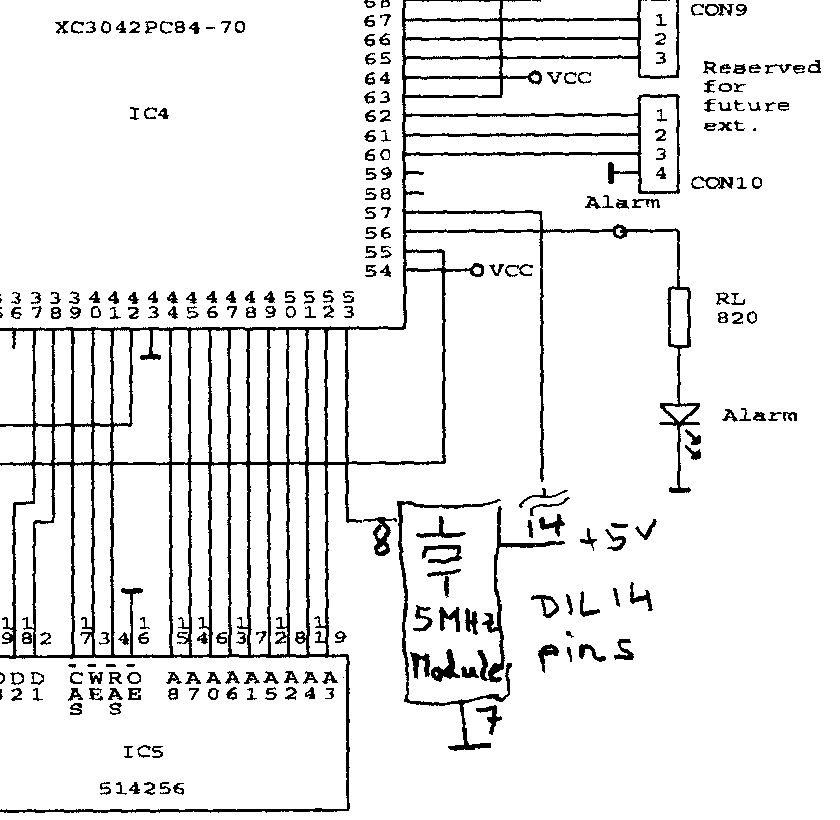
Last updated 2002-12-22
I tried two differnt decoders just to compare their performance. The first one is the Rob Alblas design the other one is from the NOAA95 group in Italy.
The decoder I use in regular service is the Rob
Alblas design. Meanwhile I constructed two of them. Both of
them working identical. I made one change to my boards though
for reasons to be described below. Additionally there seems to
be some strange behaviour of the PLL that could not be resolved
in discussion with Rob until now.
Top view of my version of the Alblas decoder, still with the
original oscillator circuit (top left).

Although the Alblas decoder is very easy to construct and to
align ( many thanks for that Rob ) one problem remained with
both specimen of my decoders: there were some ten to twenty
distorted lines during each satellite pass in the captured
images even when the signal from the satellite was very strong.
To find the reason for those bad lines I tried nearly
everything one could imagine.
Main candidate was the PLL. So I exchanged every component of
that, tried different component values and even complete
different oscillator designs, VCXOs included.
--- Wait for some satellite passes to check for success -- No
improvement!
I tried different receivers. Yes, as you know, I own two very
different designs.
--- Wait for some satellite passes to check for success -- No
improvement!
Tried different computers, tried different software
--- Wait for some satellite passes to check for success -- No
improvement!
Swapped all cables, checked antenna, swapped preamps
--- Wait for some satellite passes to check for success -- No
improvement!
Considered even constructing another decoder design ( see below
).
Took me in total about three months of frustrating research.
--- Wait for some satellite passes to check for success -- No
improvement!
Finally I tried the nearly unthinkable: I fiddled around the
clock oscillator of the "elastic memory" and .... something
happened !! I tried various combinations of Xtals and
associated Capcitors with no reliable results.
--- Wait for some satellite passes to check for success --
sometimes improvement, sometimes not!
So I decided to take the radical cure, totally removed the
original oscillator cicuit and replaced it by an integrated
oscillator module.
--- Wait for some satellite passes to check for success -- and
voilá, no bad lines anymore !
So if you ever suffered from distorted lines with Alblas
decoder although receiving strong signals, consider replacing
the oscillator circuit of the elastic memory by some readymade
oscillator module connected to pin 53 of the elastic memory
FPGA. I tried two different modules. One with frequency of 5.12
MHz the other one with 10 (!!) MHz. Both are working!
See my simple modification of the decoder below. FPGA IC4 is used for "elastic memory" in Rob's design

To my knowledge there are only two decoder designs published
for the DIYer namely the Alblas decoder and the Noaa95
decoder. Both designs could be called digital in contrast to
analog decoders. Just to compare the performance of both ( and
as a last resort if all my bad-lines-experiments had failed,
see above ) I also constructed one specimen of the NOAA95
decoder. Construction was done with the help of an ISA bus
prototype board and wiring was done by threading enamelled
copper wire, since PCBs from the NOAA95 group are sold out.
Only the decoder part was built actually, not the IF- and
demodulator part.
To make the story short: performance ( or better say noise
margin ) equalled that of the Alblas decoder up to single
lines.
Analog decoders are said to give better ( up to 3dB ) signal to
noise margin than digital decoders because of their
integrate-and-dump function for bit recovery. Up to now I have
not found any published benchmark that compares different
designs of decoders to confirm this advantage of analog
decoders. Remember, 3 dB advantage translates to double the
surface area of a dish antenna or double the length of a beam
antenna, so this could have serious impact on total system
performance. Please give me a note if you have
more information on that aspect.